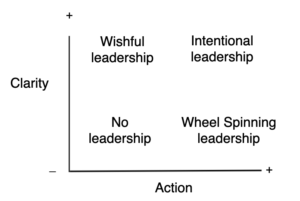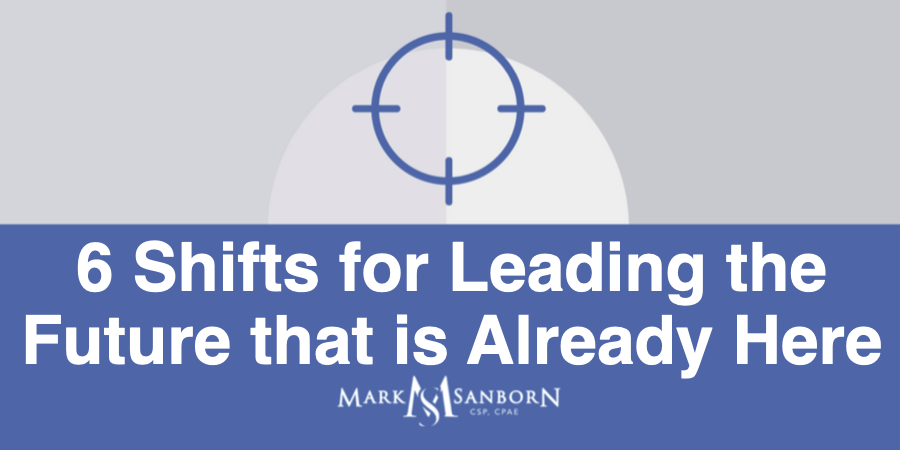Something very unusual happened because of Covid 19 that hadn’t happened before.
The world had experienced pandemics and cataclysmic events before, but Covid was different.
Covid changed many things, but it accelerated everything. The future arrived not incrementally over time but all at once.
Covid ended the present and replaced it with the future.
Time honored traditions and proven practices were upended. While everyone was dealing with the health risks and behavioral changes needed to cope, most didn’t notice the sudden arrival of the future.
Things have not returned to normal, nor will they ever, especially if you define normal as pre 2020. Yet how many organizations struggle not just to make sense of the future that is here now, but what they should be doing and doing differently to thrive?
I’ve studied the future that is here now and based my findings on a national research project and interaction with hundreds of clients and leaders over the past few years.
I’ve identified six critical shifts you need to make to lead the future that is here now:
1. Certainty to confidence.
We are frequently surprised and sometimes shocked.
Why?
Because we think we are nearly certain what is going to happen. Certainty is one of five social rewards deeply important to the brain. It feels good to think we know the future.
Nobody talked about Covid until it happened as we were all pretty certain there wouldn’t be a plague in 2020 even though we knew it was always a possibility.
We were surprised when Russia invaded the Ukraine even though war has been a constant of human history.
In addition to certainty often being an illusion, there is another problem: a sense of certainty can provide a false sense of well being. It makes us flat-footed and inattentive.
If we can’t realistically be all that certain, especially about the big events and forces that change the world, what can we do? The alternative is to make sure we have the confidence to be successful in an uncertain world. “We will find a way” must be more than a bromide; it must be a learned behavior.
Confidence is about anticipating what might happen and preparing as much as possible. It is also about developing a mindset and skillset that enables team members to be confident that regardless of what happens, there is a way to respond successfully.
Does your organization teach resilience? Have you captured and codified what you learned from the Covid crisis? Are your contingency plans up to date? Do you discuss the far fetched yet possible scenarios that might upend your business model? And, most importantly, have you identified the necessary skills to respond to whatever happens? These are the things that develop practical confidence.
2. Planning and process to agility and experimentation.
In a world that changes slowly, planning and process create efficiency and need only periodically adjusted.
In a post-Covid world where everything has changed at once, planning and process are an anchor and impediment to leading well.
Experimentation and agility trump planning and process. That isn’t to say that planning isn’t important, or that you shouldn’t plan. And process can save time and effort. But neither last very long without being affected by unforeseen events, new customer demands or better technology.
Experimentation: trying new things or old thing in new ways. Try lots of things and if they work, keep doing them until they don’t. If they don’t work do them differently or quit doing them. Don’t let bureaucracy, slow decision making and outdated rules slow the process. For experimentation to work well it needs to be done quickly.
Agility is about flexibility and speed, and adapting quickly. It serves you well in both experimentation and responding to circumstances you didn’t expect or can’t control.
Planning and process–as practiced before Covid–take a backseat to agility and experimentation.
3. Motivation to inspiration.
There is nothing like a crisis to force us to grapple with the big questions of life.
Why do I work so hard? What difference does it make? What difference do I make?
Many of the rewards we received from our work changed or disappeared during Covid. What kept many going was inspiration. Inspiration is about the meaning we derive from work, or even why we work.
Inspiration is motivation to the power of purpose. It is about linking the typical rewards of work to the reason for the work and the bigger difference a person’s work makes to others.

Inspiration doesn’t have to be mysterious or complicated to create. It is about understanding the important ‘whys’ of work and fulfilling them. It develops from the work itself and how the leader is able to demonstrate the importance and impact of that work.
4. Experience to emotion.
This applies as much to your employees as your customers.
Emotions are intertwined with everything we do and they are the single biggest factor in how we make decisions, whether we are conscious of them or not.
In the past, experience was key. Companies wanted to create great experiences for customers. It is, however, to have a good experience and not be happy. Maybe the experience was positive but not what you’d hoped for or expected.
I believe experiences are a means to and end: how do those experiences make people feel?
Are your customers happier that they chose you than a competitor?
And are your employers happier they work for you and not somewhere else?
A friend of mine says we shouldn’t pay employees to be happy. He’s half right: we should pay employees to produce results, but how they feel about where they work affects the results they produce.
People are increasingly less willing to be “successful” but feel miserable.
Your customers live in a tough world. If you can create positive emotion when they interact with you, they’ll tell others, spend more and come back.
The customer experience is important, but how the customer feels about that experience is critical. Few companies design and deliver for positive emotion. Nor do they design the workplace for positive emotions.
They should.
5. Structure to culture.
Do you know anybody who refers to an org chart during a crisis?
Did you?
Whether at home or at work, it is culture, not structure, that determines behavior, and it is one of the most talked about and least understood concepts in business today.
Culture is what we think and believe, which then determines what we do and what we accomplish. It is the engine that drives what gets done and how it gets done.
An org chart shows relationships between people and departments, but it doesn’t tell us anything about teamwork or camaraderie, shared values or commitment.
Many organizations have a culture by default, for good or for bad, that a leader inherits. But a great leader can create and shape culture by design.
Here are the five levers that create or maintain a positive culture:
Hiring/Firing
Communication/Meetings
Training/Education
Pay/Incentives
Philosophy/Practices
(To learn more about creating culture, check out my book, The Intention Imperative, Chapter 5.)
6. Action to intentionality
Tom Peters famously said, “Ready, Fire, Aim” which was as much about innovation and experimentation as taking action. Inertia is the enemy of progress, and all too often organizational progress is mired by lack of action.
“Don’t just sit there, do something!” or “Luck favors momentum” are popular cliches.
A bias for action is a good thing IF it is the right action and if it takes an organization to WHERE it wants to be.
Look at the most successful leaders you know. What do they all have in common?
To understand what one thing all successful leaders have in common, consider what all unsuccessful leaders have in common:
They either aren’t clear on what they’re trying to do, or they’re clear but aren’t doing the right things consistently. Both waste time and money and leave organizations stuck in the status quo.
What all great leaders have in common is intentionality: being crystal clear on what you’re trying to achieve and taking the right actions every day to achieve it.
Compare the four leadership styles below. Which are you?

Conclusion
The first factor in each of the six shifts above are the past. They served organizations well…in the past.
The second in each of the six shifts above are the future. They will serve you best….in the future that is here now.
Mark Sanborn is an award winning speaker and Leadership Expert in Residence at High Point University, the Premier Life Skills University. For more information about his work, visit www.marksanborn.com.








